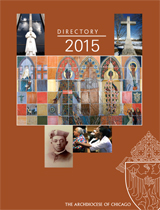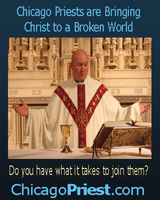February 3, 2008
University staff learns about Catholic identity
St. Xavier University, billed as Chicago’s oldest, was founded by the Sisters of Mercy in 1846, there was no doubt as to what made it a Catholic institution, or, more specifically, a Mercy institution.
Even 50 years ago, students and visitors would have seen a uniformly Catholic student body and sisters in habits in classrooms and hallways, said Mercy Sister Sue Sanders, the vice president for heritage and mission.
But now, with students, faculty and staff from various religious backgrounds, and few sisters working at the university, its Catholic identity and mission must be intentionally passed on, Sanders said.
To help, the university started a unique peer mentoring program, being offered this year to staff members. The program brings university staff—people who work in the registrar’s office or library to food service or housekeeping workers—together roughly once a month for five months to talk about what it means to be a Catholic university, and how it carries out the mission of the Sisters of Mercy of the Americas.
Other universities who have received grants from the Lilley Fellows Program to foster their religious identities have created programs for their faculty, Sanders said, but St. Xavier is the only one to open such a program for staff.
Because of the limitations of the funding, the peer mentoring program is offered for staff and for faculty in alternating years.
St. Xavier administrators decided to include staff because students interact with them as much, or more, than faculty, said Michael O’Keeffe, an associate professor of theology who runs the program with Sanders. Staff members select and train student mentors, advise student clubs and help students register for classes.
“In all areas, members of the SXU community are in constant contact with the students,” O’Keeffe said. “This is a way to recognize all the ways in which students are formed and to create an awareness of the diversity in Catholic education.”
At St. Xavier, which has seen its enrollment grow in recent years, the majority of the 5,700 students are Catholic, Sanders said, or at least identify themselves as such, but many don’t know much about the faith.
“One of the important things is to educate them about faith traditions in general,” she said.
“The conversation cannot be limited to a few faculty and a few administrators,” O’Keeffe said. “We have a sizable staff and faculty that’s not Catholic. How do you carry on a mission without having a litmus test? What the mentoring project does is try to provide the opportunity to wrestle with the texts about what it means to be at a Catholic university.”
The wrestling comes in a social setting, after work for most people, with refreshments.
“We try to make it attractive and interesting and fun,” Sanders said. “We try to give a little background on what it means to be a Catholic. They often see it as rules and dogma that don’t apply to them.”
The decline in the number of sisters has also made it more important for the school to communicate explicitly what it means to be sponsored by the Mercy sisters.
“It asks our lay colleagues to step up and learn about the Mercy charism,” she said. “I walk down the hall and hear people say, ‘I’m not sure Mother McAuley would do it that way.’”
As a Mercy institution, “we are really very much about service,” Sanders said. “We’re not just doing it because it’s a good thing to do, or because you get something out of doing service—which you do—but because the Gospel asks you to.”
While the university does not expect its staff to embrace Catholic dogma, it does want them to understand the underpinnings of the faith.
“Irrespective of your faith tradition, we want you to understand human dignity, that we are all made in the image of God and that everyone is important. If our faculty and staff do not communicate that to our students, there is not much difference between us and a secular university.”
 Catholic
New World - Newspaper for the Archdiocese of Chicago
Catholic
New World - Newspaper for the Archdiocese of Chicago Archdiocese of Chicago Directory
Archdiocese of Chicago Directory Oficjalne wydawnictwo Archidiecezji Chicago w języku polskim
Oficjalne wydawnictwo Archidiecezji Chicago w języku polskim